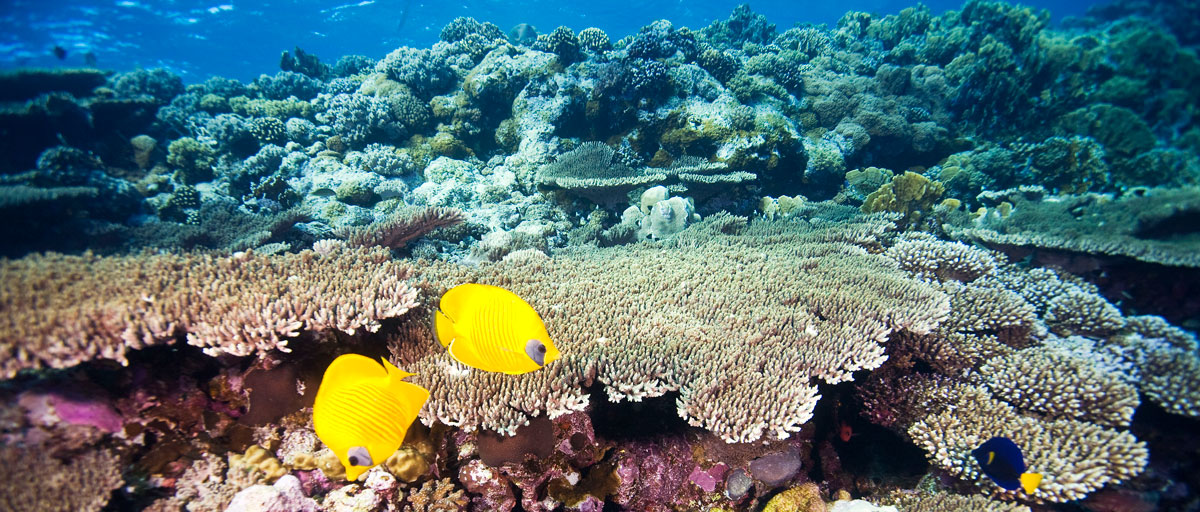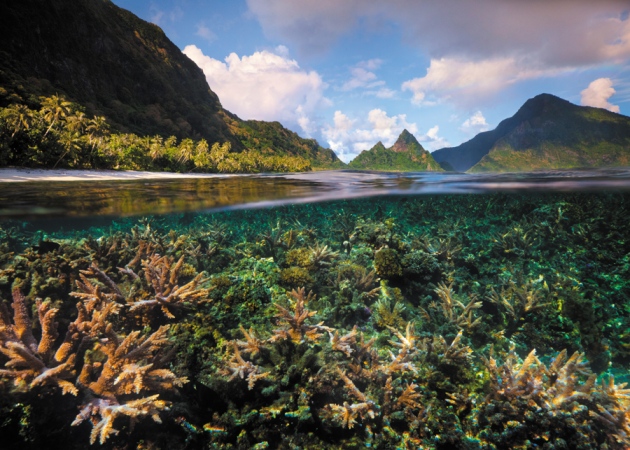
Floris van Breugel/Naturepl.com
Reefs thrive in the hot waters of American Samoa that would kill other corals.
Off the coast of American Samoa, the tropical sun beats down on a shallow tidal lagoon, heating the water to a sizzling 35 °C for a few hours each day. Such temperatures would kill off most coral reefs, and yet the Samoan lagoon hosts courtyards of antler-like branching corals and mound corals the size of refrigerators. “The fact that they’re there means they’ve adapted to survive,” says Steve Palumbi, a marine biologist at Stanford University in California. “The real question is: how did they do that and can all corals do that?”
Palumbi is just starting to understand how these Samoan corals thrive in such extreme conditions. And he thinks he might be able to harness that ability to create a reef of hardy coral with a chance of surviving the hot seas that are expected to result from climate change. Starting in August, he and his team are going to try to plant “the smartest future reef we can imagine”.
Palumbi is part of a small group of coral researchers around the world tackling such issues to throw threatened reefs a lifeline. Their ultimate intent is to launch a programme of ‘human-assisted evolution’, creating resistant corals in controlled nurseries and planting them in areas that have been — or will be — hard-hit by changing conditions. “It’s a brave new world of working with corals in this way,” says Ruth Gates, a marine biologist at the University of Hawaii at Manoa who, along with coral geneticist Madeleine van Oppen at the Australian Institute of Marine Science in Townsville, is helping to pioneer the field.
The work is not without controversy. Although no one is yet attempting to create genetically modified corals, some researchers are concerned that human-assisted evolution goes too far down the slippery slope of altering natural systems. “If you’re basically farming a reef, you’ve taken a natural habitat and you’ve converted it,” says Steve Vollmer, a coral geneticist at Northeastern University’s Marine Science Center in Nahant, Massachusetts, who feels that more needs to be known before embarking on such programmes. “It’s like going to the Midwest and taking grasslands and making it into soy. There are huge implications to doing this.”
In hot water
Coral reefs have been besieged in recent decades by everything from warming waters to ocean acidification, disease, overfishing and pollution. According to Status of Coral Reefs of the World: 2008, a synthesis report1 by hundreds of scientists and environmental managers, 19% of the world’s coral reefs have been lost since 1950 and another 35% are threatened or in critical condition. Some areas have suffered disproportionately: the Caribbean, for example, has lost 80% of its reefs since the 1970s (ref. 2). By the end of this century, researchers expect ocean waters to drop from a pH of 8.1 to 7.9 or lower, and to warm by at least 2 °C, averaged across the globe. “It’s kind of like if you pull the plug on the bathtub and the water is rushing out — that’s the state of corals,” says Palumbi.
Reef-restoration projects have been focusing on the Caribbean and other hard-hit spots for more than 20 years. In these programmes, small samples are taken from local reefs and grown in controlled coral nurseries. After a few months, fragments the size of a hand or larger can be ‘outplanted’ to a reef using underwater cement, where the coral will continue to grow. Such projects have shown that transplantation and reef restoration can be done on a small scale. But transplanted corals grow more slowly and have higher mortality rates than normal3. “Coral restoration has always been highly expensive and slow and inefficient,” says Palumbi. “Figuring out how to do this in a smarter way is our goal.”
That smarter way takes advantage of the surprising resilience and resourcefulness of some corals and the symbiotic algae that live inside them. “Sometimes we find reefs that are doing very, very well in places that you would least expect to find them,” says Gates — such as a reef off Taiwan that lies below the waste-water outfall pipe of a nuclear power plant and experiences temperature fluctuations of between 6 °C and 8 °C per day. “By all of our understanding, we would expect those corals to all be dead. But they’re not, they’re flourishing.”
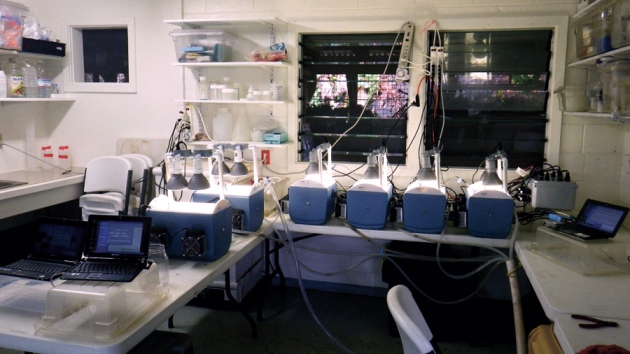
Steve Palumbi
Corals get put through a ‘stress test’ in cooler boxes that have been adjusted to expose them to high temperatures in the lab.
Waters with a reduced pH are expected to dissolve coral skeletons — but in Palau in the western Pacific Ocean, researchers have found4 reefs that are bigger and more diverse in relatively acidic waters than the Pacific average. Another study5 found that dire predictions about the frequency of future coral-bleaching events — mass die-offs when stressed corals lose their symbiotic algae — are reduced by 20–80% if the models take into account corals’ ability to adapt after previous bleaching events. That delays predicted mass reef deaths by about a decade.
So far, researchers have only a handful of hints as to what makes some corals resilient. In a study6 published in 2013, Palumbi and his colleagues, including Daniel Barshis, a marine biologist at Stanford, compared two populations of the reef-building coral Acropora hyacinthus at their field site off Ofu Island in American Samoa. One population lives in the toasty pool where temperatures reach 35 °C during summer low tides and fluctuate by up to 6 °C daily; the other, less isolated by tides, has to deal with temperatures of only about 29 °C. The team placed samples in controlled tanks and shocked them with temperatures of nearly 3 °C above normal for four days. All of the corals bleached by the end of the fourth day. But those from the hotter pool survived for longer and had higher expression of 60 genes, including well-known thermal-tolerance genes such as those that make heat-shock proteins and antioxidant enzymes.
Palumbi and Barshis think that genetic fitness and acclimatization both play important roles in boosting tolerance. Their analyses suggest that corals can ‘toughen up’ over the course of their lifetimes in response to environmental conditions. Those in the hot pool are physiologically primed to tolerate additional heat stress, “like an athlete who’s been training every day since a very early age”, says Barshis.
A promising twist is that the more heat-tolerant species seem also to be more transplant-friendly. After experimentally planting some 400 samples from the two reef areas back into the two pools, Palumbi and his team found that the corals from the hotter pools transplanted more efficiently and grew faster than those from the cooler pools.
This August, Palumbi and his colleagues plan to begin an experimental restoration project on Sili Reef off Ofu Island. To select the best corals, the researchers will rely on their extensive data for the area, including growth measurements and transcriptomes — blueprints of the part of the genome that is actively transcribed into proteins. They also plan to use data from a portable stress test for corals that Palumbi is developing — “like a human treadmill test for cardiac function”, he says. He and his team have built tanks out of 7.5-litre cooler boxes rigged with lights, heaters and chillers that can dose corals with a controlled bout of high physiological stress. By monitoring bleaching and chlorophyll content, they should be able to predict how corals might respond to potential bleaching conditions.
Using all this information as a guide, they will handpick the hardiest, fastest-growing and most heat-resistant corals for their smart reef. At the same time, they will build a second reef from corals selected at random. They will then monitor reef survival over several years. “The question is: can we do better if we have a lot of information about the individual corals?” says Palumbi. “Honestly, I don’t know the answer.”
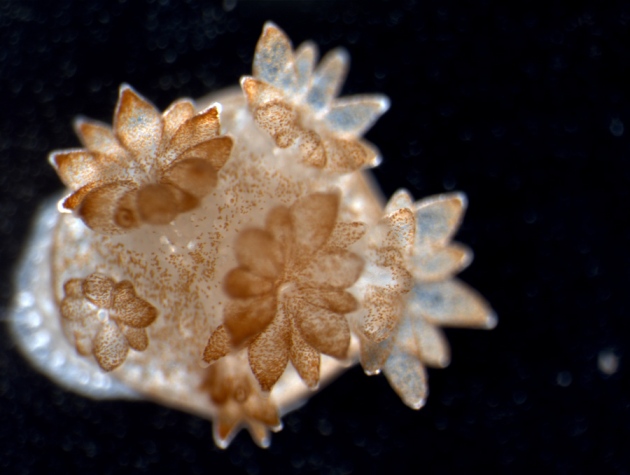
Emily Howells/AIMS
This juvenile coral was raised from sperm and eggs in the lab, and then infected with symbiotic algae that are used to coping with elevated temperatures.
Legacy of survival
Others have found encouraging evidence that stress resistance gained through acclimatization can be passed on to offspring. Unpublished work by Gates, led by the University of Hawaii’s Hollie Putnam, shows that adult cauliflower corals (Pocillopora damicornis) exposed to stress during brooding produce larvae with increased resilience to heat and ocean acidification. The team hypothesizes that this transgenerational protection is caused by epigenetic changes: the modification of molecular tags on the genome that affect gene expression.
Gates and van Oppen are aiming to look specifically at areas that have already survived massive bleaching events, such as Moorea in French Polynesia, the central Great Barrier Reef in Australia, and the Seychelles, where 97% of corals in the inner islands died following the 1997–98 El Niño oceanic warming event. (A nursery has already been created from the Seychelles corals that survived, and fragments grown from them have been planted onto reefs to aid their recovery.) Gates and van Oppen aim to cross-breed corals that have survived such stressful bleaching, and to track the resilience of the offspring.
Their ideas won Gates and van Oppen the 2013 Paul G. Allen Ocean Challenge prize of US$10,000, along with an invitation to apply for multimillion-dollar funding. Depending on how much of that funding comes through, they also aim to use heat and acidity to stress corals before they breed, to see if and how tolerance gets passed down the generations. Beginning in May, van Oppen and her team will start collecting adults of the branching coral Pocillopora acuta from the Great Barrier Reef, and will grow them in the Australian Institute of Marine Science’s massive National Sea Simulator, an aquarium facility that provides controlled tanks to replicate open-ocean conditions.
Ultimately, Gates and van Oppen hope to create a ‘seed bank’ of gametes and fertilized embryos from extreme settings in which corals persist despite the odds — including the shallow reefs skirting Coconut Island, Hawaii, where both temperature and pH fluctuate drastically, reaching upper limits similar to those expected in the open ocean by 2050. The seed bank would add to efforts spearheaded by the US Smithsonian Institution, in collaboration with Hawaiian and Australian bodies, which are already banking coral sperm and embryonic cells.
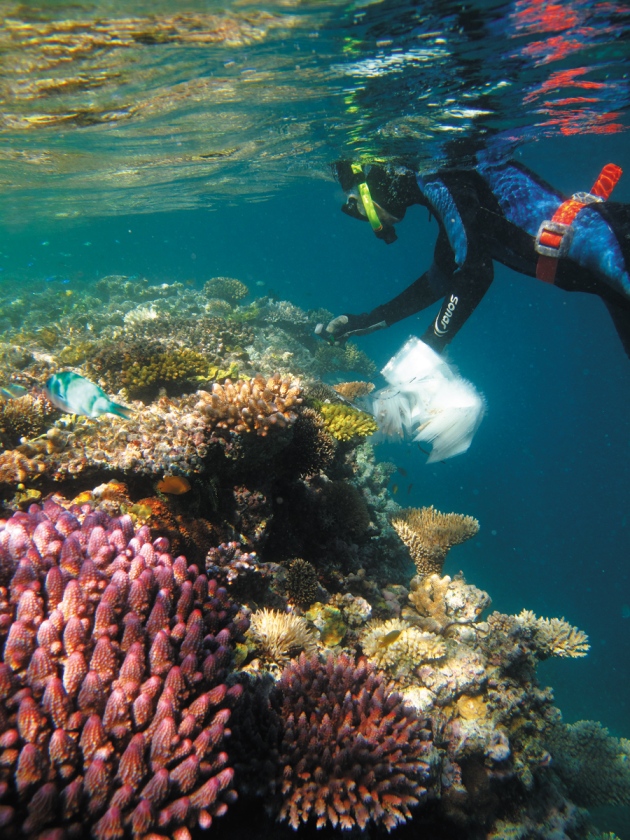
James Woodford
Madeleine van Oppen collects corals for study and selective breeding.
A final, important piece of the puzzle is the corals’ symbiotic algae: these are shorter-lived and faster-evolving than their hosts, and research has shown that they can pass along thermal tolerance. One study7, for example, found that juvenile corals inoculated with strains of algae collected from a warm reef known for heat resistance grew well when exposed to temperatures up to 32 °C, whereas samples of the same coral inoculated with algae from a cooler reef suffered bleaching and tissue death.
Andrew Baker, a marine biologist at the University of Miami in Florida, and his colleagues discovered8 that symbionts from a lineage called clade D tend to become more prevalent in some corals when they are heat stressed, suggesting that the algae are better able than other strains to survive such conditions, and that they help their hosts to survive too. Since then, studies have shown9 that clade D symbionts, in particular types D1 and D1a, are prevalent in a wide variety of corals that have survived extreme bleaching events. Putnam, Gates and their colleagues have found10 that a different strain, C15, seems to be dominant in heat-resistant corals near Moorea.
Researchers such as Baker are starting to think about the possibility of intentionally seeding coral reefs with hardier strains of algae to help them to resist the perils of climate change. But it is still unclear whether it will be possible to manipulate symbiont populations effectively in the wild, where environmental conditions might cause the corals to favour one type of alga over another.
Workers at existing coral nurseries and farms have been sending samples of coral and symbionts to researchers for genetic sequencing, while keeping tabs on which organisms fare well in heat shocks or disease outbreaks. Researchers have banked hundreds of genotyped strains from a handful of coral species, including the critically endangered staghorn coral (Acropora cervicornis) from locations in the Caribbean, says Les Kaufman, a marine biologist at Boston University in Massachusetts.
Help or harm
The days of trying to build reefs with designer-made corals are still in the future. But as the research heads in that direction, some are wary that such tinkering might do more harm than good.
Selecting for traits such as resistance to heat or acidification might lead to a genetic bottleneck, for example. “Selective-breeding programmes may effectively reduce the capacity of corals to adapt to future changes in environmental conditions by narrowing genetic variation,” says David Miller, a coral biologist at James Cook University in Townsville. And that is if selective breeding in corals even works. It is too soon even to tell whether acid and heat resistance are strongly heritable, he says.
Miller and others point out that cross-breeding to enhance specific traits in crops and dogs, for example, often comes at the expense of other traits. “There’s often a ‘trade-off’ effect, so that, for example, more-stress-tolerant individuals are likely to grow more slowly,” says Miller. Selecting for resilience against heat and acidity could hypothetically lead to higher susceptibility to disease, for instance.
Manuel Aranda, an evolutionary molecular biologist at the Red Sea Research Center at King Abdullah University of Science and Technology in Thuwal, Saudi Arabia, agrees that breeding might come at a cost. But he says that the serious decline in reef health warrants exploring all available options. “If you think about losing an entire ecosystem, you want to start somewhere.”
Until recently, says Baker, the goal for coral-reef management was simply to create marine reserves and reduce the pressures of pollution and fishing, hoping that that would leave reefs strong enough to deal with climate change. “The pendulum has sort of shifted as people have realized just how dire the situation is,” says Baker. “We need to do more than that. We need to take action.”
Some 500 million people depend in some way on coral reefs for food and income, and the livelihoods of another 30 million are entirely dependent on reefs1. For Gates, statistics like those, combined with the facts of climate change, make the pursuit of assisted evolution necessary and urgent. “We don’t have a lot of time,” she says.

 The Texas oil company Dan Hughes Co. was caught illegally fracking near the Everglades last month and public outcry continues to grow. Our friends at Progress Florida need your help to ensure that Hughes Co. faces serious consequences for its actions, not just a slap on the wrist from Gov. Rick Scott’s administration.
The Texas oil company Dan Hughes Co. was caught illegally fracking near the Everglades last month and public outcry continues to grow. Our friends at Progress Florida need your help to ensure that Hughes Co. faces serious consequences for its actions, not just a slap on the wrist from Gov. Rick Scott’s administration.





